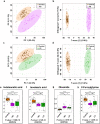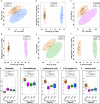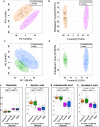Untargeted urinary metabolomics for bladder cancer biomarker screening with ultrahigh-resolution mass spectrometry
- PMID: 37328580
- PMCID: PMC10275937
- DOI: 10.1038/s41598-023-36874-y
Untargeted urinary metabolomics for bladder cancer biomarker screening with ultrahigh-resolution mass spectrometry
Abstract
Bladder cancer (BC) is a common urological malignancy with a high probability of death and recurrence. Cystoscopy is used as a routine examination for diagnosis and following patient monitoring for recurrence. Repeated costly and intrusive treatments may discourage patients from having frequent follow-up screenings. Hence, exploring novel non-invasive ways to help identify recurrent and/or primary BC is critical. In this work, 200 human urine samples were profiled using ultra-high-performance liquid chromatography and ultra-high-resolution mass spectrometry (UHPLC-UHRMS) to uncover molecular markers differentiating BC from non-cancer controls (NCs). Univariate and multivariate statistical analyses with external validation identified metabolites that distinguish BC patients from NCs disease. More detailed divisions for the stage, grade, age, and gender are also discussed. Findings indicate that monitoring urine metabolites may provide a non-invasive and more straightforward diagnostic method for identifying BC and treating recurrent diseases.
© 2023. The Author(s).
Conflict of interest statement
The authors declare no competing interests.
Figures






Similar articles
-
Untargeted ultra-high-resolution mass spectrometry metabolomic profiling of blood serum in bladder cancer.Sci Rep. 2022 Sep 7;12(1):15156. doi: 10.1038/s41598-022-19576-9. Sci Rep. 2022. PMID: 36071106 Free PMC article.
-
Untargeted metabolomics of bladder tissue using liquid chromatography and quadrupole time-of-flight mass spectrometry for cancer biomarker detection.J Pharm Biomed Anal. 2024 Mar 15;240:115966. doi: 10.1016/j.jpba.2024.115966. Epub 2024 Jan 8. J Pharm Biomed Anal. 2024. PMID: 38217999
-
Targeted and untargeted urinary metabolic profiling of bladder cancer.J Pharm Biomed Anal. 2023 Sep 5;233:115473. doi: 10.1016/j.jpba.2023.115473. Epub 2023 May 22. J Pharm Biomed Anal. 2023. PMID: 37229797
-
LC-MS metabolomics of urine reveals distinct profiles for non-muscle-invasive and muscle-invasive bladder cancer.World J Urol. 2022 Oct;40(10):2387-2398. doi: 10.1007/s00345-022-04136-7. Epub 2022 Sep 4. World J Urol. 2022. PMID: 36057894 Review.
-
Urinary proteomics and metabolomics studies to monitor bladder health and urological diseases.BMC Urol. 2016 Mar 22;16:11. doi: 10.1186/s12894-016-0129-7. BMC Urol. 2016. PMID: 27000794 Free PMC article. Review.
Cited by
-
Metabolomics, Genetics, and Environmental Factors: Intersecting Paths in Abdominal Aortic Aneurysm.Int J Mol Sci. 2025 Feb 11;26(4):1498. doi: 10.3390/ijms26041498. Int J Mol Sci. 2025. PMID: 40003964 Free PMC article.
-
Unmasking the Metabolite Signature of Bladder Cancer: A Systematic Review.Int J Mol Sci. 2024 Mar 15;25(6):3347. doi: 10.3390/ijms25063347. Int J Mol Sci. 2024. PMID: 38542319 Free PMC article.
-
Identification of Diagnostic Biomarkers for Colorectal Polyps Based on Noninvasive Urinary Metabolite Screening and Construction of a Nomogram.Cancer Med. 2025 Apr;14(7):e70762. doi: 10.1002/cam4.70762. Cancer Med. 2025. PMID: 40200572 Free PMC article.
-
A Workflow for Meaningful Interpretation of Classification Results from Handheld Ambient Mass Spectrometry Analysis Probes.Int J Mol Sci. 2024 Mar 20;25(6):3491. doi: 10.3390/ijms25063491. Int J Mol Sci. 2024. PMID: 38542461 Free PMC article. Review.
-
Untargeted metabolomic profiling of serum and urine in kidney cancer: a non-invasive approach for biomarker discovery.Metabolomics. 2025 Jul 1;21(4):97. doi: 10.1007/s11306-025-02294-4. Metabolomics. 2025. PMID: 40593405 Free PMC article.
References
-
- Ng K, Stenzl A, Sharma A, Vasdev N. Urinary biomarkers in bladder cancer: A review of the current landscape and future directions. Urol. Oncol. Semin. Orig. Investig. 2021;39:41–51. - PubMed
Publication types
MeSH terms
Substances
LinkOut - more resources
Full Text Sources
Medical

